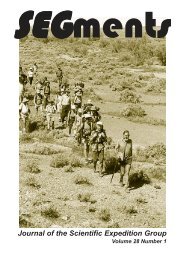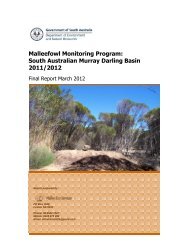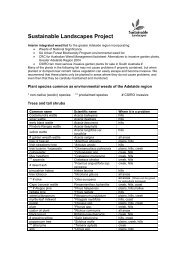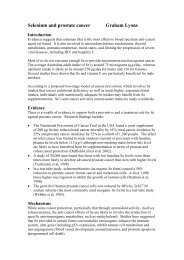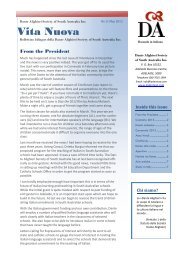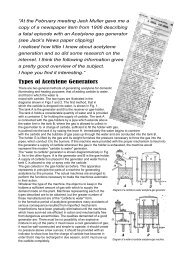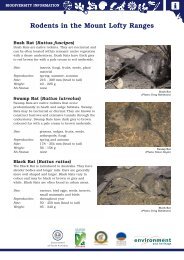Seaford Rail Vegetation Management Plan - Communitywebs.org
Seaford Rail Vegetation Management Plan - Communitywebs.org
Seaford Rail Vegetation Management Plan - Communitywebs.org
You also want an ePaper? Increase the reach of your titles
YUMPU automatically turns print PDFs into web optimized ePapers that Google loves.
<strong>Seaford</strong> <strong>Rail</strong> Extension <strong>Vegetation</strong> <strong>Management</strong> <strong>Plan</strong><br />
and filling, spot spraying and hand pulling. The way to carry out each method effectively and<br />
safely is detailed below.<br />
Cut and Swab<br />
Cut off all stems as low as possible using a chainsaw or pruning saw, secateurs or<br />
long-handled loppers. The cut must be horizontal so that the herbicide rests on the<br />
cut area while being absorbed, rather than running down the side of the stem;<br />
Stumps will be left in the ground so as to not disturb the soil and to help retain the soil<br />
in place i.e. reduce the likelihood of soil erosion;<br />
Remove all stems from the stump, so that no active (or green) branches/shoots<br />
remain, no matter how small they are;<br />
Liberally swab all cut surfaces immediately with the herbicide mixture. This must be<br />
done preferably within half a minute, or immediately if possible. The cut surface<br />
cannot be allowed to dry out, otherwise the herbicide will be much less effective. Use<br />
a paintbrush, swabber or squeeze bottle (laboratory) to apply the herbicide mixture.<br />
Add a dye to the herbicide mixture that will help indicate where swabbing has already<br />
been done;<br />
The tissues that take up and move the poison are immediately under the bark layer,<br />
so concentrate on applying the poison around the outer rim of the stump;<br />
Follow up work may be required. If the stumps re-sprout which can be common with<br />
some species, then cut and swab or spray the new regrowth with herbicide;<br />
The most effective time of the year to cut and swab plants is when they are actively<br />
growing, which varies between species.<br />
Drill and Fill<br />
Drill a steeply angled hole into the plant's cambium layer (where sap flows just<br />
beneath the bark layer) with a cordless drill, using a 10mm drill bit;<br />
The holes should be as close to the base of the plant as possible, and it is essential<br />
for the hole to be steeply angled into the cambium otherwise the herbicide will not be<br />
absorbed into the sap flow;<br />
Immediately after the hole has been drilled fill with herbicide. Syringes (without the<br />
needle) or squeeze bottles can be used to administer the herbicide into the hole;<br />
Holes are drilled every 2.5-5cm until the base of the plant has been circled;<br />
Follow up work may be required. If the plant re-sprouts which can be common with<br />
some species, then the process needs to be repeated.<br />
Frilling<br />
For large and medium sized trees and shrubs with a large stump or lignotuber the<br />
following “Frilling” method is recommended. It can be used in conjunction with the cut<br />
90




